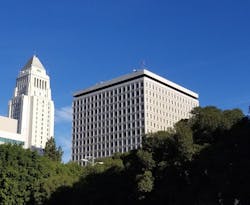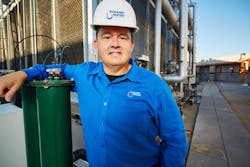Treatment System Installed at LA City Hall East Saved 1.1M Gallons of Water
A pilot program to evaluate better methods to save water in drought-stricken California demonstrates that governments and businesses can save millions of gallons of water annually by changing how they treat the water used to cool their buildings or used in industrial processes.
After 18 months of operation at LA City Hall East, a treatment system installed by Scottsdale, Ariz.-based Dynamic Water Technologies (DWT) showed more than a 90 percent savings in chemical costs, and a water-use reduction from 5.95 million gallons a year to 4.78 million, a savings of 1.17 million gallons — or 20 percent less water.
After an extensive evaluation process, DWT was selected by the Department of Energy's High Impact Technology Catalyst Program, which evaluates emerging technologies that save energy and natural resources, to participate in the pilot program. The Energy Department's National Renewable Energy Laboratory served as an independent monitor. The NREL tracked the system's performance from April 2018 to October 2018. NREL released the final numbers of the study in September 2019.
"In addition to the reduced chemical costs and water savings, the DWT system also removed historical scale from the condenser tubes and cooling tower media. Removal of scale from the condenser tubes improves heat transfer and should improve the operating efficiency of the cooling system," said Mark Roussel, Assistant Director of the Building Maintenance Division at the City of Los Angeles.
In comparison to other traditional and non-traditional methods used by the city, city leaders found the results were so conclusive that the Los Angeles City Department of Water and Power contracted with Dynamic Water Technologies to install the reactors at the city's downtown headquarters as part of the city's proactive efforts to save water.
In the LA City Hall study, NREL reported a 19% reduction in makeup water and a nearly 66 percent decrease in blowdown. Before the DWT installation, water was recycled between three to five times. After the installation, water cycles exceeded 10 cycles.
"By reusing the water for the additional cycles, we are able to save millions of gallons of water," said DWT co-founder, Neil Ginsberg. "Makeup and blowdown are two areas where any large building — whether it's a government building, hospital, shopping center, office complex, power plant, refinery, industrial processes — they all expend millions to tens of millions of gallons of water. Reducing those gallons also saved on sewer and treatment costs."

